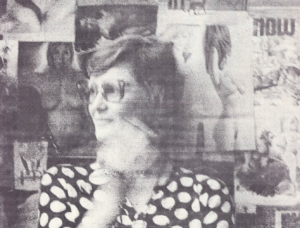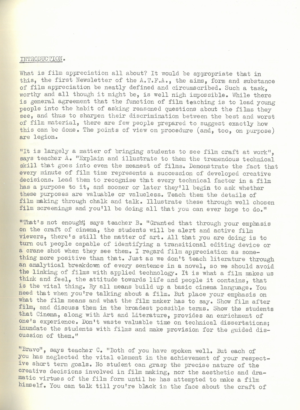It is fitting that in this, the tenth issue of The Newsletter, some form of retrospective editorial be written, not only to mark the importance of the occasion, but also to comment on the developments in film teaching that have taken place since Issue One way back in 1964.
There is the ever present risk in assessing what undoubtedly have been real advances in the volume and scope of film-study work since 1964 to overstate the case. It is true that more schools and more teachers are now treating film and television seriously, and that there is evidence that administrators in the State Education Department are encouraging teachers to begin such work. The fact of A.T.F.A.’s existence indicates the degree of interest being taken in screen education, whatever forms the work takes in practice, and the Association rightfully prides itself in having offered some real contribution to this gathering momentum of interest. Nonetheless the horizon is still somewhat cloudy, and this because of an absence of accurate, documented material on exactly what is being done where and by whom. We really don’t know with any degree of certainty how many schools are handling a study of films; we don’t know whether what is being done is a curriculum study or a Club or out-of-hours activity; we don’t know with which forms the teaching is attempted; we don’t know if the teachers who have tried film appreciation feel satisfied with their efforts. In short, we can merely assert generally that more film appreciation work is in evidence now than in 1964, without being able to specify the nature and quality of the work. In an attempt to overcome this absence of necessary information, we earnestly ask readers of The Newsletter – who, presumably, represent the main body of teachers tackling film – to complete as fully as they can the questionnaire contained in this issue. The importance of the information that an enthusiastic response to the questionnaire would produce cannot be overestimated. It would enable the Association to speak with authority when we are asked – as we so often are – to produce facts and figures about film teaching in Victoria. It would indicate to us the sorts of services that the Association should be supplying. It would lend weight to any requests that we might submit to State Film Centre and the Visual Education Branch of the Education Department for the inclusion of films related to film-study courses in their collections. Similarly, the information would give real point to any negotiations the Association undertakes with a commercial company like Sixteen Millimetre Pty Ltd for the provision of long term feature film hiring by schools, and the local production of A.T.F.A. sponsored study extracts. Without this information, the Association will continue to be nothing more than an organisation whose efforts are marked only by a commendable earnestness; with it the Association will be in a position to speak and act with purpose and authority.
You will notice that this Issue carries three segments of considerable value – an A.T.F.A. membership list (included in the hope that Association members might care to get in touch with one another to discuss what they are doing), a comprehensive book and periodical list kindly supplied by Mr W. Perkins of Tasmania, and a full index of this and the previous nine issues which constitute Volume One of The Newsletter. Preparing the index proved to be a salutory experience. One was forced to re-read these comments and articles which seemed to be so apt and forceful two or three years ago. Apt and forceful they might have been then, but not so now. Two articles in particular were a source of acute embarrassment, those entitled “What’s Happening On Television?” If you recall, the essence of these articles was that there was more worthwhile material available on commercial television than teachers were prepared to concede, and that it was high time that we took some of TV’s dramatic series more seriously. Shows like The Defenders, Doctor Kildare, Naked City were referred to, and their merits praised. Fair enough. While the editor still sticks to these opinions as they were formulated in the context of 1964 and 1965, times, unhappily, have changed. Commercial television as we now know it is, I believe, pretty well bereft of anything that could be called intelligent, stimulating or entertaining. Exceptions could be made in the cases of Coronation Street, The Dick Van Dyke Show and the re-runs of Hancock’s Half Hour, but as for the rest… We have the dreary predictabilities of F Troop, Gomer Pyle, Gilligan’s Island, Mister Ed, My Mother the Car (all played out to gales of canned laughter), and the umpteenth revival of episodes of The Fugitive and The New Breed. No one can argue that commercial TV as it stood in 1964 was anywhere near perfect, but at least there was the chance that the following through of series like The Defenders, The Doctors and the Nurses, Fred Astaire Theatre and Gunsmoke would sooner or later produce a solid thirty or fifty minutes of narrative entertainment, and, on odd occasions, something more. But those days have gone. Like the man said, friends, it’s a desert. The one ray of hope for television, however, has been the improvement in the nature of ABV 2’s programming, not only with the advent of unique public affairs programmes like the admirable This Day Tonight and Impact, but also with those thoroughly well written and produced series like The Marriage Lines, Love Story, Blackmail and Softly, Softly. At the least, when one watches channel 2 one doesn’t get the impression that the masters of television believe the average viewer has the interests of a retarded nine year old and a brain the size of a salted peanut. Perhaps all of us interested in a quality of visual presentations are at fault here. Perhaps we need to write and voice criticisms of television when it fails to do what is well within its province to do, and, of equal importance, to indicate our approval when television – especially commercial television – shows some inspiration. It could be argued that it is the apathy of those viewers with the interest and capacity to see where television could be improved that has allowed commercial TV to sink to the relatively mindless state in which one finds it at the moment.
In any event, there are tasks aplenty for the teacher of film appreciation, and in expressing the hope that readers have found The Newsletter to be of value over the last three years, the Editor trusts that it will have proved to be of even greater value when the editorial for the tenth issue of Volume Two comes to be written.
[from Film Appreciation Newsletter vol. 1, no. 10]


